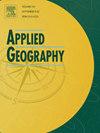Land degradation neutrality in mountainous region: dynamics, driving factors, and management implications
IF 5.4
2区 地球科学
Q1 GEOGRAPHY
引用次数: 0
Abstract
Land Degradation Neutrality (LDN), as a critical target of Sustainable Development Goal, faces significant temporal constraints with only a 15-year implementation window from its conception in 2015 to the target year of 2030. This urgency necessitates comprehensive assessment of land degradation, particularly in ecologically fragile mountainous regions characterized by complex ecosystem interactions and multiple disturbance factors. Based on the scientific conceptual framework for LDN indicator system, this study proposes a novel dominant-recessive assessment methodology and implements a multi-scale land degradation evaluation. Focusing on the northern Qinling Mountains as a case study, we employed trend analysis to systematically examine land degradation status and LDN implementation across multiple spatial scales. Our findings reveal substantial areas failing to meet LDN goals at both administrative district and grid scales. Our findings reveal substantial areas failing to meet LDN goals at both administrative district and grid scales. Through the Geodetector analysis, we investigated the relationships between land degradation patterns and 12 natural and socio-economic factors. The results demonstrate that mean annual temperature, normalized difference vegetation index and altitude emerge as primary drivers of land degradation in the northern Qinling Mountains, collectively explaining over 9 % of the variability. Furthermore, our analysis indicates that the interaction between any two factors exhibits a non-linear enhancement effect on land degradation processes. These findings provide valuable insights into the mechanisms understanding of land degradation dynamics, offer scientific foundations for mountain ecosystem conservation strategies, and contribute to the theoretical advancement of LDN frameworks.
山地土地退化中性:动态、驱动因素和管理意义
土地退化零化(LDN)作为可持续发展目标的一项关键目标,面临着重大的时间限制,从2015年的概念到2030年的目标年只有15年的实施窗口期。这一紧迫性要求对土地退化进行全面评估,特别是在生态系统相互作用复杂、干扰因素多的生态脆弱山区。基于科学的LDN指标体系概念框架,提出了一种新的显性-隐性评价方法,实现了多尺度土地退化评价。以秦岭北部为例,采用趋势分析方法,系统考察了不同空间尺度下的土地退化现状和LDN实施情况。我们的研究结果显示,在行政区域和网格尺度上,有大量地区未能达到LDN目标。我们的研究结果显示,在行政区域和网格尺度上,有大量地区未能达到LDN目标。通过地理探测器分析,研究了土地退化模式与12个自然因素和社会经济因素之间的关系。结果表明,年平均气温、归一化植被指数和海拔高度是北秦岭土地退化的主要驱动因素,共同解释了9%以上的土地退化变率。此外,我们的分析表明,任何两个因素之间的相互作用对土地退化过程都表现出非线性的增强效应。这些发现为理解土地退化动态机制提供了有价值的见解,为山地生态系统保护策略提供了科学依据,并有助于推进LDN框架的理论发展。
本文章由计算机程序翻译,如有差异,请以英文原文为准。
求助全文
约1分钟内获得全文
求助全文
来源期刊

Applied Geography
GEOGRAPHY-
CiteScore
8.00
自引率
2.00%
发文量
134
期刊介绍:
Applied Geography is a journal devoted to the publication of research which utilizes geographic approaches (human, physical, nature-society and GIScience) to resolve human problems that have a spatial dimension. These problems may be related to the assessment, management and allocation of the world physical and/or human resources. The underlying rationale of the journal is that only through a clear understanding of the relevant societal, physical, and coupled natural-humans systems can we resolve such problems. Papers are invited on any theme involving the application of geographical theory and methodology in the resolution of human problems.
 求助内容:
求助内容: 应助结果提醒方式:
应助结果提醒方式:


